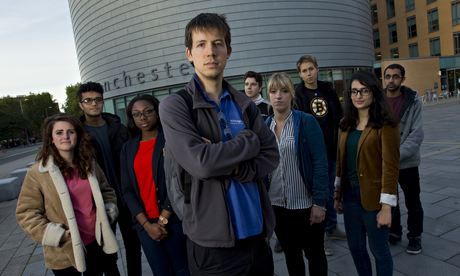Jean Dreze in The Hindu 11 April 2014
Why does Gujarat have indifferent social indicators, in spite of having enjoyed runaway economic growth and relatively high standards of governance?
Gujarat’s development achievements are moderate, largely predate Narendra Modi, and have as much to do with public action as with economic growth.
As the nation heads for the polling booths in the numbing hot winds of April, objective facts and rational enquiry are taking a holiday and the public relations industry is taking over.
Narendra Modi’s personality, for one, has been repackaged for mass approval. From an authoritarian character, steeped in the reactionary creed of the Rashtriya Swayamsevak Sangh (RSS) and probably complicit in the Gujarat massacre of 2002, he has become an almost avuncular figure — a good shepherd who is expected to lead the country out of the morass of corruption, inflation and unemployment. How he is supposed to accomplish this is left to our imagination — substance is not part of the promos. The Bharatiya Janata Party (BJP), too, is being reinvented as the party of clean governance, overlooking the fact that there is little to distinguish it from the Congress as far as corruption is concerned.
Spruced up image
Similarly, Gujarat’s image has been spruced up for the occasion. Many voters are likely to go the polling booths under the impression that Gujarat resembles Japan, and that letting Mr. Modi take charge is a chance for the whole of India to follow suit.
Some of Mr. Modi’s admirers in the economics profession have readily supplied an explanation for Gujarat’s dazzling development performance: private enterprise and economic growth. This interpretation is popular in the business media. Indeed, it fits very well with the corporate sector’s own view that the primary role of the state is to promote business interests.
However, as more sober scholars (Raghuram Rajan, Ashok Kotwal, Maitreesh Ghatak, among other eminent economists) have shown, Gujarat’s development achievements are actually far from dazzling. Yes, the State has grown fast in the last twenty years. And anyone who travels around Gujarat is bound to notice the good roads, mushrooming factories, and regular power supply. But what about people’s living conditions? Whether we look at poverty, nutrition, education, health or related indicators, the dominant pattern is one of indifferent outcomes. Gujarat is doing a little better than the all-India average in many respects, but there is nothing there that justifies it being called a “model.” Anyone who doubts this can download the latest National Family Health Survey report, or the Raghuram Rajan Committee report, and verify the facts.
To this, the votaries of the Gujarat model respond that the right thing to look at is not the level of Gujarat’s social indicators, but how they have improved over time. Gujarat’s progress, they claim, has been faster than that of other States, especially under Mr. Modi. Alas, this claim too has been debunked. Indeed, Gujarat was doing quite well in comparison with other States in the 1980s. Since then, its relative position has remained much the same, and even deteriorated in some respects.
An illustration may help. The infant mortality rate in Gujarat is not very different from the all-India average: 38 and 42 deaths per 1,000 live births, respectively. Nor is it the case that Gujarat is progressing faster than India in this respect; the gap (in favour of Gujarat) was a little larger twenty years ago — in both absolute and proportionate terms. For other indicators, the picture looks a little more or a little less favourable to Gujarat depending on the focus. Overall, no clear pattern of outstanding progress emerges from available data.
In short, Gujarat’s development record is not bad in comparative terms, but it is nothing like that of say Tamil Nadu or Himachal Pradesh, let alone Kerala. But there is another issue. Are Gujarat’s achievements really based on private enterprise and economic growth? This is only one part of the story.
When I visited Gujarat in the 1980s, I was quite impressed with many of the State’s social services and public facilities, certainly in comparison with the large north Indian states. For instance, Gujarat already had mid-day meals in primary schools at that time — decades later than Tamil Nadu, but decades earlier than the rest of India. It had a functional Public Distribution System — again not as effective as in Tamil Nadu, but much better than in north India. Gujarat also had the best system of drought relief works in the country, and, with Maharashtra, pioneered many of the provisions that were later included in the National Rural Employment Guarantee Act. Gujarat’s achievements today build as much on its ability to put in place functional public services as on private enterprise and growth.
Misleading model
To sum up, the “Gujarat model” story, recently embellished for the elections, is misleading in at least three ways. First, it exaggerates Gujarat’s development achievements. Second, it fails to recognise that many of these achievements have little to do with Narendra Modi. Third, it casually attributes these achievements to private enterprise and economic growth. All this is without going into murkier aspects of Gujarat’s experience, such as environmental destruction or state repression.
At the end of the day, Gujarat poses an interesting puzzle: why does it have indifferent social indicators, in spite of having enjoyed runaway economic growth for so long, as well as relatively high standards of governance? Perhaps this has something to do with economic and social inequality (including highly unequal gender relations), or with the outdated nature of some of India’s social statistics, or with a slackening of Gujarat’s earlier commitment to effective public services. Resolving this puzzle would be a far more useful application of mind than cheap propaganda for NaMo.
Jean Dreze in The Hindu on 11 May 2014
If Gujarat is a model, then the real toppers in development indicators, like Kerala and Tamil Nadu, must be supermodels
In an earlier article published on this page (“The Gujarat Muddle,” April 11, 2014), I pointed out that Gujarat’s development achievements were hardly “model” class. This is pretty firm ground: the same point has been made by a long list of eminent economists. Yet confusion persists, so I decided to take another look at the data, just in case I had been carried away.
Summary indexes
This time I looked at a bunch of summary indexes based on multiple development indicators. One advantage of summary indexes is that they make it harder to “cheat” by focussing selectively on particular indicators that happen to suit one’s purpose. The Human Development Index (HDI) is a good starting point. The latest HDI computations for Indian states, presented by Reetika Khera and myself in Economic and Political Weekly, place Gujarat in the 9th position among 20 major States — very close to the middle of the ranking. In the same paper, we also looked at a summary index of child well-being, nicknamed Achievements of Babies and Children (ABC), which is based on four indicators related to child nutrition, survival, education and immunisation respectively. In the ABC ranking, too, Gujarat occupies the 9th position among 20 major States.
This time I looked at a bunch of summary indexes based on multiple development indicators. One advantage of summary indexes is that they make it harder to “cheat” by focussing selectively on particular indicators that happen to suit one’s purpose. The Human Development Index (HDI) is a good starting point. The latest HDI computations for Indian states, presented by Reetika Khera and myself in Economic and Political Weekly, place Gujarat in the 9th position among 20 major States — very close to the middle of the ranking. In the same paper, we also looked at a summary index of child well-being, nicknamed Achievements of Babies and Children (ABC), which is based on four indicators related to child nutrition, survival, education and immunisation respectively. In the ABC ranking, too, Gujarat occupies the 9th position among 20 major States.
Another useful summary index is the Multidimensional Poverty Index (MPI). Briefly, the idea is that poverty manifests itself in different kinds of deprivation — lack of food, shelter, sanitation, schooling, health care, and so on. Starting with a list of basic deprivations, a household is considered “poor” if it has more than a given proportion (say one third) of these deprivations. There is some inevitable arbitrariness in the specification of basic deprivations, but nevertheless, the MPI is a very useful supplement to other poverty indicators. In the latest MPI ranking of Indian States, by Sabina Alkire and her colleagues at Oxford University, Gujarat comes 9th (again) among 20 major Indian States.
A new entrant in this family of summary statistics is the Composite Development Index devised by the Raghuram Rajan Committee. This index has ten components related to per capita consumption, household amenities, health, education, urbanisation, connectivity, financial inclusion, and so on, based on the latest available data. Looking at the list of component indicators, an unsuspecting reader of the mainstream media might expect Gujarat to emerge pretty close to the top of the State ranking. Alas, not. Here again, Gujarat scores 9th among 20 major States!
There is something almost uncanny about this pattern, since the summary indexes are based on very different indicators. And it’s not that I am selectively focussing on particular rankings where Gujarat happens to rank 9th out of 20. I have reported all the recent summary indexes I know of. If you don’t like them, we can always fall back on the Planning Commission’s standard poverty estimates based on per capita expenditure. But then Gujarat slips from the 9th to the 10th position among 20 major States, according to the latest estimates for 2011-12.
The Raghuram Rajan Committee also devised another interesting index: the Performance Index, which captures the progress that States are making over time in terms of the Composite Development Index. This is an important indicator, because some proponents of the Gujarat model argue that what we should look at is not the level of Gujarat’s development indicators, but how they change over time. And that is precisely what this index does. Further, it focusses on performance in the decade of the 2000s, when Gujarat was supposed to be at its best. Surely, Gujarat will fare well this time? On the contrary, it slips from 9th to 12th in the ranking of 20 major States.
In short, whichever way we look at it, Gujarat looks less like a model State than a “middle State” — far from the bottom in inter-State rankings, but far from the top too. If there is a Gujarat model, then there must also be a Haryana model and perhaps a Karnataka model. Incidentally, Maharashtra does better than Gujarat on all the summary indexes mentioned earlier. Why, then, is Gujarat held as a model and not Maharashtra? Your guess is as good as mine.
If Gujarat is a model, then the real toppers, like Kerala and Tamil Nadu, must be supermodels. Indeed, not only do Kerala and Tamil Nadu routinely come at — or near — the top in rankings of summary development indexes, they also surpass other States in terms of the speed of improvement. For instance, Kerala and Tamil Nadu do better than any other major State in terms of both level and change of the Composite Development Index. Of course, if you believe the touching story whereby Kerala’s achievements are actually based on the Gujarat model, then we are back to square one.
Why this image?
An interesting question arises: how did Gujarat acquire an inflated image? No doubt, this optical illusion partly reflects Narendra Modi’s outstanding ability to confuse the public (with a little help from his admirers in the economics profession). But perhaps it also has something to do with the fact that our perception of India is over-influenced by the large north Indian States — the former “BIMARU” States, which have dismal infrastructure, awful public services, and abysmal social indicators. Gujarat certainly shines in comparison — but so do many other States.
An interesting question arises: how did Gujarat acquire an inflated image? No doubt, this optical illusion partly reflects Narendra Modi’s outstanding ability to confuse the public (with a little help from his admirers in the economics profession). But perhaps it also has something to do with the fact that our perception of India is over-influenced by the large north Indian States — the former “BIMARU” States, which have dismal infrastructure, awful public services, and abysmal social indicators. Gujarat certainly shines in comparison — but so do many other States.
Mind you, the “G spot” (9th out of 20) may be auspicious. The number nine, according to Wikipedia, “is revered in Hinduism and considered a complete, perfected [sic] and divine number.” The Chinese, for their part, associate the number nine with the dragon, “a symbol of magic and power,” which also “symbolises the Emperor.” If the numerologists got this right, NaMo is well placed.




